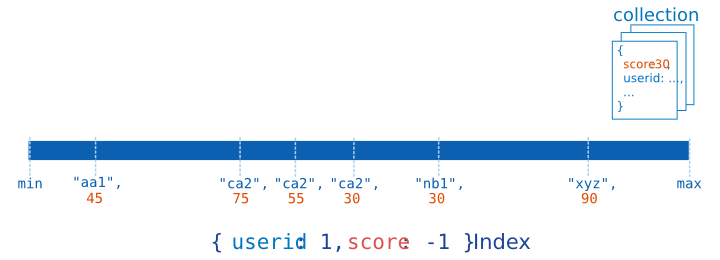- Indexes >
- 复合索引
复合索引¶
On this page
MongoDB supports compound indexes, where a single index structure holds references to multiple fields [1] within a collection’s documents. The following diagram illustrates an example of a compound index on two fields:

| [1] | MongoDB imposes a limit of 31 fields for any compound index. |
复合索引可以支持要求匹配多个键的查询。
Create a Compound Index¶
To create a compound index use an operation that resembles the following prototype:
db.collection.createIndex( { <field1>: <type>, <field2>: <type2>, ... } )
The value of the field in the index specification describes the kind of index for that field. For example, a value of 1 specifies an index that orders items in ascending order. A value of -1 specifies an index that orders items in descending order. For additional index types, see index types.
重要
You may not create compound indexes that have hashed index type. You will receive an error if you attempt to create a compound index that includes a hashed index field.
Consider a collection named products that holds documents that resemble the following document:
{
"_id": ObjectId(...),
"item": "Banana",
"category": ["food", "produce", "grocery"],
"location": "4th Street Store",
"stock": 4,
"type": "cases"
}
The following operation creates an ascending index on the item and stock fields:
db.products.createIndex( { "item": 1, "stock": 1 } )
The order of the fields listed in a compound index is important. The index will contain references to documents sorted first by the values of the item field and, within each value of the item field, sorted by values of the stock field. See 排序顺序 for more information.
In addition to supporting queries that match on all the index fields, compound indexes can support queries that match on the prefix of the index fields. That is, the index supports queries on the item field as well as both item and stock fields:
db.products.find( { item: "Banana" } )
db.products.find( { item: "Banana", stock: { $gt: 5 } } )
For details, see 前缀.
排序顺序¶
Indexes store references to fields in either ascending (1) or descending (-1) sort order. For single-field indexes, the sort order of keys doesn’t matter because MongoDB can traverse the index in either direction. However, for compound indexes, sort order can matter in determining whether the index can support a sort operation.
Consider a collection events that contains documents with the fields username and date. Applications can issue queries that return results sorted first by ascending username values and then by descending (i.e. more recent to last) date values, such as:
db.events.find().sort( { username: 1, date: -1 } )
or queries that return results sorted first by descending username values and then by ascending date values, such as:
db.events.find().sort( { username: -1, date: 1 } )
那么,下面的这个索引就可以同时支持这两种排序操作:
db.events.createIndex( { "username" : 1, "date" : -1 } )
However, the above index cannot support sorting by ascending username values and then by ascending date values, such as the following:
db.events.find().sort( { username: 1, date: 1 } )
For more information on sort order and compound indexes, see 使用索引来排序查询结果.
前缀¶
Index prefixes are the beginning subsets of indexed fields. For example, consider the following compound index:
{ "item": 1, "location": 1, "stock": 1 }
The index has the following index prefixes:
- { item: 1 }
- { item: 1, location: 1 }
For a compound index, MongoDB can use the index to support queries on the index prefixes. As such, MongoDB can use the index for queries on the following fields:
包含 item 键,或者
包含 item 和 location 键,或者
- the item field and the location field and the stock field.
MongoDB can also use the index to support a query on item and stock fields since item field corresponds to a prefix. However, the index would not be as efficient in supporting the query as would be an index on only item and stock.
However, MongoDB cannot use the index to support queries that include the following fields since without the item field, none of the listed fields correspond to a prefix index:
- the location field,
- the stock field, or
- the location and stock fields.
If you have a collection that has both a compound index and an index on its prefix (e.g. { a: 1, b: 1 } and { a: 1 }), if neither index has a sparse or unique constraint, then you can remove the index on the prefix (e.g. { a: 1 }). MongoDB will use the compound index in all of the situations that it would have used the prefix index.
Additional Considerations¶
If your collection holds a large amount of data, and your application needs to be able to access the data while building the index, consider building the index in the background, as described in 后台创建.
To build or rebuild indexes for a replica set, see 在复制集上创建索引.
Some drivers may specify indexes, using NumberLong(1) rather than 1 as the specification. This does not have any affect on the resulting index.
